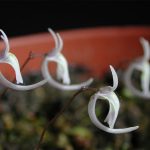 A tapering projection, usually short and curved;
A tapering projection, usually short and curved;
A short shoot of the stem bearing leaves and/or flowers and fruit;
(In flowers) a slender hollow extension (usually) of the perianth, often containing nectar.
The hollow, tubular projection from the base of a petal or sepal, often producing nectar; a short side twig on a tree.
A cylindrical or conical, sometimes curved, hollow projection from the back or base of a petal or sepal, usually containing nectar.
A hollow projection from a petal, often containing nectar; the short flowering shoots on such plants as apples, pears or hoyas. which normally continue to flower and fruit for several years.
A tubelike projection from the base of a flower corolla. It usually contains nectar.
A sharp projecting part of a bone.
An abnormal, spike-shaped outgrowth of bone tissue, often found on the bottom of the back of the heel. Bone spurs may be tender when gentle pressure is applied and usually cause sharp pain when weight is placed on the foot. Over time, if a protective bursa (a fluid-filled sac that acts as a cushion) develops over the spur, the bursa may become inflamed, causing swelling and increased pain. Favoring the sore heel may alter the gait and contribute to back pain. When bursitis is associated with a heel spur, the foot should be rested and protected from pressure by a special pad. Nonsteroidal anti-inflammatory drugs (NSAIDs) or localized corticosteroid injections may be recommended. Surgery may become necessary if the condition persists and is painful.
A pointed or sharp projection, typically made of bone.